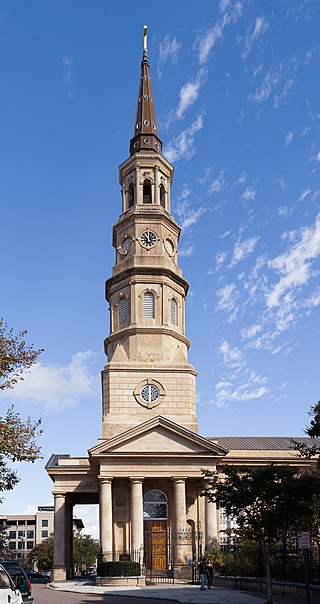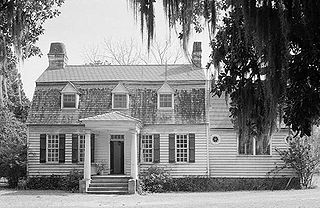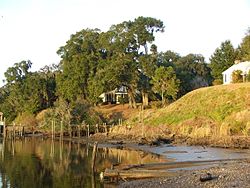
Robert Mills was a South Carolina architect known for designing both the first Washington Monument, located in Baltimore, Maryland, as well as the better known monument to the first president in the nation's capital, Washington, DC. He is sometimes said to be the first native-born American to be professionally trained as an architect. Charles Bulfinch of Boston perhaps has a clearer claim to this honor.

Drayton Hall is an 18th-century plantation located on the Ashley River about 15 miles (24 km) northwest of Charleston, South Carolina, and directly across the Ashley River from North Charleston, west of the Ashley in the Lowcountry. An example of Palladian architecture in North America and the only plantation house on the Ashley River to survive intact through both the Revolutionary and Civil wars, it is a National Historic Landmark.

The Robert William Roper House is an historic house at 9 East Battery in Charleston, South Carolina. It was built on land purchased in May 1838 by Robert W. Roper, a state legislator from the parish of St. Paul's and a prominent member of the South Carolina Agricultural Society, whose income derived from his position as a cotton planter and slave holder. The house is an outstanding example of early 19th-Century Greek Revival architecture, built on a monumental scale. Although there are now two houses between Roper House and White Point Garden to the south, for a decade after its construction nothing stood between the house and the harbor beyond, making it the first and most prominent house to be seen by visitors approaching Charleston by sea.

St. Philip's Church is an historic church at 142 Church Street in Charleston, South Carolina. Its National Historic Landmark description states: "Built in 1836, this stuccoed brick church features an imposing tower designed in the Wren-Gibbs tradition. Three Tuscan pedimented porticoes contribute to this design to make a building of the highest quality and sophistication." On November 7, 1973, it was added to the National Register of Historic Places and designated a National Historic Landmark.

Strawberry Chapel is a parochial chapel of ease in the lower part of St. John's, Berkeley Parish in Berkeley County, South Carolina that was built in 1725. It is on Strawberry Chapel Road between South Carolina State Highway 8-44 and the West Branch of the Cooper River. Bordering Strawberry's property is the South Carolina State owned historic site of the “Town of Childsbury.” It was a planned community that was settled in 1707. The town no longer exists. They were named to the National Register of Historic Places on April 26, 1972.

The Oakland Plantation House which is also known as Youghall or Youghal Plantation House, was built about 1750 in Charleston County, South Carolina about 7 mi (11 km) east of Mount Pleasant. It is located about 1 mile (1.6 km) south of U.S. Route 17 on Stratton Place. It was named to the National Register of Historic Places on July 13, 1977.

Botany Bay Plantation Wildlife Management Area is a state preserve on Edisto Island, South Carolina. Botany Bay Plantation was formed in the 1930s from the merger of the Colonial-era Sea Cloud Plantation and Bleak Hall Plantation. In 1977, it was bequeathed to the state as a wildlife preserve; it was opened to the public in 2008. The preserve includes a number of registered historic sites, including two listed in the National Register of Historic Places: a set of three surviving 1840s outbuildings from Bleak Hall Plantation, and the prehistoric Fig Island shell rings.

Prospect Hill is an historic plantation house on Edisto Island, South Carolina. The two-story Federal house is significant for its architecture and ties to the production of sea island cotton. Constructed about 1800 for Ephraim Baynard, it sits on a bluff overlooking the South Edisto River. In 1860, William Grimball Baynard owned Prospect Hill. Baynard was an elder in the Edisto Island Presbyterian Church, a Justice of the Peace, a Justice of the Quorum, and the owner of 220 slaves. When Baynard died in 1861, his son William G. Baynard acquired the house. The house was listed in the National Register of Historic Places on 28 November 1986.

The Summit Plantation House is an historic building in Adams Run, South Carolina, USA. The house was built for William and Amarinthia Wilkinson in 1819. The house was listed in the National Register on July 28, 1983.

The Wilkinson-Boineau House is a significant example of an early 19th-century Greek Revival residence with minor 20th-century alterations. William Wilkinson, a planter, established a village, Wilkinsonville, about 1830 that bears his name, and the house was the first one built. He lived for most of the year at his plantation on Swinton Creek.

Adams Run is an unincorporated community and census-designated place (CDP) in Charleston County, South Carolina, United States. It was first listed as a CDP in the 2020 census with a population of 421.
Japonica Hall, also known as the Major J.J. Lucas House, is a historic home located at Society Hill, Darlington County, South Carolina. It was built in 1896–1897, and is a 2+1⁄2-story over basement brick residence with a rusticated first story and a second story. It is in the Beaux Arts style with a facade reminiscent of Italian Renaissance palazzos. It has a projecting hipped-roof central entrance bay and a one-story Tuscan order verandah. It was the home of Major James Jonathan Lucas, a prominent local railroad builder and businessman. Lucas, who represented Charleston in the state House of Representatives from 1856 to 1862, was a prominent Confederate artillery officer in the defense of Charleston during the American Civil War.

Ashley Hall Plantation is a historic plantation complex located on the Ashley River near West Ashley, Charleston County, South Carolina. The plantation was established in the early 1670s by Stephen Bull. The property includes a small tabby-walled house with a 20th-century second story addition, the ruins of the Georgian plantation house (1704) which was burned in 1865 to prevent its destruction by Union forces, a monument to the second Governor William Bull, two prehistoric Indian archaeological sites, and two 18th century well sites associated with the plantation. The tabby house is considered one of the oldest standing houses in the state.
Barnwell House, also known as Prospect Hill Plantation, is a historic home located at Adams Run, Charleston County, South Carolina. It consists of the front or main portion dating from 1878 and the rear section from early to mid-19th century. The main part is a 2+1⁄2-story building, with a stuccoed brick first story and weatherboarded upper story. The front façade features a one-story portico with a bell cast hip roof supported by two solid Doric order fluted columns. It was listed on the National Register of Historic Places in 1980.
Paul Grimball House Ruins is a historic archaeological site located at Edisto Island, Charleston County, South Carolina. The stuccoed tabby house was built about 1682. In August 1686, the house was occupied, sacked, and possibly burned by the Spanish on a raid up the North Edisto River. The remains consist of a 12 feet high corner portion of a stucco covered tabby wall.
King Cemetery (38CH1590) is a historic African American cemetery near Adams Run, Charleston County, South Carolina, containing at least 183 graves. Oral history documents the extensive use of the graveyard during slavery and continuing into the first half of the 20th century. Distinctive characteristics include the placement of grave goods, ranging from ceramics to bottles to household furniture, on the grave and the use of plant materials as markers.

U.S. Coast Guard Historic District is a national historic district located at Sullivan's Island, Charleston County, South Carolina. The district encompasses three contributing buildings and one contributing structure on Sullivan's Island. The property was established as a life saving station in 1891. The district contains the station house/administration building, boathouse, garage, and signal tower, which are laid out in an "L"-shaped court loosely organized around the bunker/sighting station. Also on the property is the non-contributing Charleston Light.

Secessionville Historic District is a national historic district located near Folly Beach, Charleston County, South Carolina. It extends into the city of Charleston, South Carolina. The district encompasses six contributing buildings, one contributing site, and one contributing site in Secessionville. The district includes the summer homes of several leading James Island planters, the site of the American Civil War Battle of Secessionville, the unmarked grave of over 300 Union soldiers, and the remains of Fort Lamar, constructed about 1862.

The Hanckel-Barclay House, also known as Chestnut Hill, is a historic house in the Dunn's Rock community near Brevard, Transylvania County, North Carolina, bordered by the French Broad River and US Highway 276. The house was listed on the National Register of Historic Places in 1999.
Parkers Ferry is a small unincorporated community in Charleston County, South Carolina. Neighboring communities include Willtown Bluff, Jericho, Osborne, and Adams Run. Parker's Ferry falls within Adams Run's zip code, 29426. The elevation of Parkers Ferry is 20 feet, and it is in the Eastern Time Zone. Penny Creek is the primary water source of this community.



















